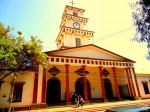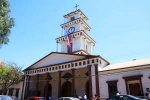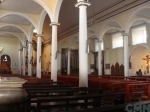Cathedral of Copiapo. Copiapo - CHILE
Indigenous Copayapu Valley were conquered by the Inca Tupac Yupanqui troops to 1425. From that time is still the Inca Trail which through the desert and the Andes reached the capital of Cuzco. In 1536, Diego de Almagro left a group of Spanish in this valley, then continued its way south. Subsequently, in 1540 also passes Pedro de Valdivia, but just a few years later, Francisco de Aguirre picked up the first settlement in what was the main indigenous valley seat.
Copiapo developed slowly until the gold mines discovered in the early eighteenth century, which marks the launch and growth of the economy and population of Copiapo. Seeing the importance mining in order to accelerate the progress of the kingdom colony governor, Jose Manso de Velasco, enacted in 1744, creating a new population of Spanish under the title of villa "Villa de San Francisco de la Selva Copiapo". Expropriated land from the Indians, extending the new town to the northeast of the first group of houses, known today as the Chimba. The designated site then for the square and the church are the same now occupied. The parish church was in the distribution of plots, the half block west of the Plaza de Armas.
After building their homes, the priest with the Jesuit Varas Villegas masons delineated with the plans of the church and its cemetery, initiating construction works in 1748. In 1750 the ecclesiastical building was already up, but only opened its doors in 1766. It was at that time that the traditional stillness of Copiapo began to be disturbed by the "pernicious habit" of outsiders and the people mining also alarmed the female population with far-fetched and lavish costumes.
In 1796 an earthquake destroyed the church, going to serve as such for 55 years, the Chapel of the Jesuits. In 1840 began the construction of a new parish, but in 1849 when the roof was missing only place the French architect Jean Herbage recommended against the use of adobe gear and decided to bounce the building. An Englishman, William Rogers, 16 carpenters, taking over the new building which opens to the public in 1851. The new cathedral, built in wood, has a marked influence of neocláscico English, which is accentuated by the symmetry of the two parish houses and their details in moldings and cornices.
The church has a structure based on beams and pillars fir U.S. brought as ballast in ships and oak Maule. The large classical portico, columns and triangular pediment develops in the width of the three ships of typical basilica plan. The bell tower, which rises above the choir loft, has three bodies downward square surrounded each of twelve columns, giving originality to the cathedral. In both an octagonal lantern stands on the chancel. Inside the church you can see a beautiful silver shrine, and a wooden altar decorated by neoclassical Italian artist G. Fiorani.




